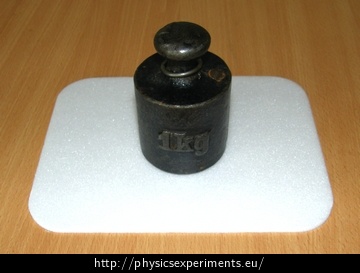Conversion of Kinetic Energy to Internal Energy: Falling Weight
Experiment number : 1940
Goal of experiment
We will visualise the transformation of kinetic energy of a falling weight into internal energy when it lands. This will be manifested by a local increase in temperature.
Theory
We can easily show the conversion of kinetic energy to potential energy, and vice versa. However, conversion of these types of energy to internal energy is more challenging to demonstrate. We do not have everyday experience with falling objects raising their temperature and the temperature of the pad after the object landing. Nevertheless, this phenomenon occurs, only the increase in temperature is usually very small and therefore difficult to measure. The kinetic energy of a falling object is transformed at the moment it lands in part as work done during its non-elastic deformation and in part as an increase in internal energy of the object and the pad it lands on. This increase of internal energy is manifested by a local increase in temperature – and that is what we are going to demonstrate in this experiment.
Tools
Thermal imaging camera, polystyrene pad (a coaster used to sell packed cheese was used in our experiment), weight (in this experiment 1 kg) or any other object of similar mass and size with a matte surface.
Procedure
We let the weight fall repeatedly from the height of approximately one meter on the polystyrene pad. Its temperature locally increases at the place of impact by ones of °C.
Sample result
A successful execution of the experiment is shown in the video below. The thermal imaging camera can barely recognize the falling weight, because its temperature (and therefore its colour on the thermogram) is the same as the temperature of the surroundings.
A thermal imaging camera FLIR i7 was used during the making of this video. The temperature scale of colours was chosen between 18 °C and 24 °C, emissivity ε = 0.95.
Technical notes
A weight with a mass of one kilogram falling from the height of one meter can be dangerous if it were to hit the students; it can also damage the floor under the pad – please pay extreme attention to the conditions under which you conduct the experiment!
Weights used in schools often have a glossy metallic surface. However, that is inconvenient for this experiment – such a weight has low emissivity, reflects heat radiation from surrounding objects and a thermal imaging camera can then determine its temperature as much higher than that of its surroundings. Students can then interpret the increase in temperature of the pad as common heat transmission during the contact between the pad and the weight, instead of conversion of kinetic energy into internal energy.
Pedagogical notes
This experiment is useful for introducing the term internal energy U, or more specifically, for transitioning from the law of mechanical energy conservation \[E_\mathrm{k}\,+\,E_\mathrm{p}\,=\,konst.\] to the more general law of energy conservation \[E_\mathrm{k}\,+\,E_\mathrm{p}\,+\,U\,=\,konst.\]
For example, you can begin with the following thought process: If we neglect air resistance, mechanical energy is conserved during free fall, i.e. potential energy gradually transforms into kinetic energy. However, after hitting the ground, both kinetic and potential energy equal zero (both with respect to the ground). That brings up the question about what happened to the law of mechanical energy conservation, where did the mechanical energy get “lost”. This opens up the potential for students’ hypotheses, between which we can often hear the opinion that the energy “moved to the pad”. That is the time to conduct our experiment.
We can also connect the experiment to the concept of heat conductivity. If we use a metal pad instead of the polystyrene one and conduct the same experiment, we will not record any measurable increase in temperature – the local increase in temperature at the point of impact is almost immediately minimized by the dissipation of heat into its surroundings. This issue is analysed further in the experiments Thermal Conductivity of Plastic and Metal I. a Thermal Conductivity of Plastic and Metal II.
Similar experiment
Instead of the kinetic energy of a free fall we can use the kinetic energy of a blow – see experiment Conversion of Kinetic Energy into Internal Energy: Blow with a Mallet.








